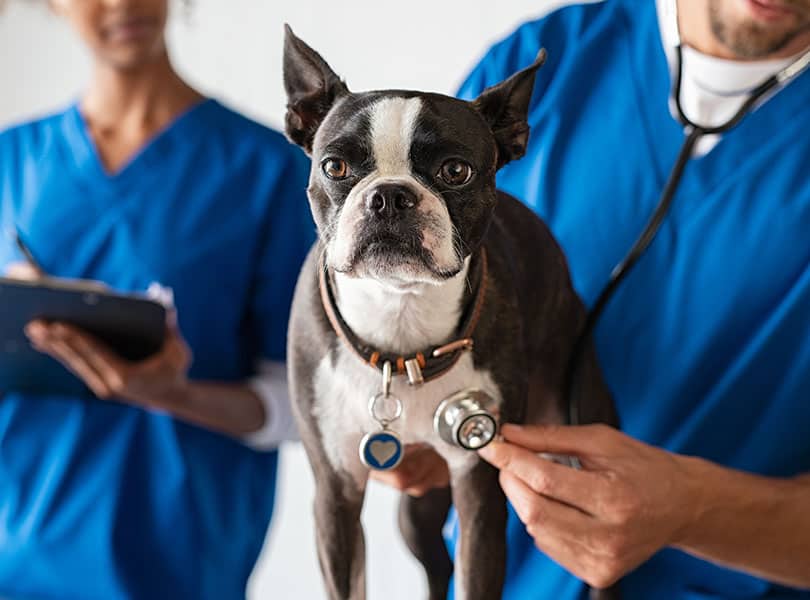The Duty of Ultrasound and CT Check in Modern Veterinary Practices: Insights From Experienced Professionals
In modern-day vet techniques, ultrasound and CT scans considerably enhance analysis capabilities. These imaging techniques give crucial understandings into animal health and wellness, guiding therapy decisions. Experienced experts acknowledge the unique advantages of each modality. Ultrasound provides real-time analyses, while CT checks provide elaborate physiological details. Understanding their applications and roles increases crucial concerns regarding their influence on person results and the future of veterinary diagnostics. What insights can be gained from their incorporated use?
Comprehending Ultrasound in Vet Medicine
Ultrasound is a vital analysis tool in veterinary medicine, offering a non-invasive method to picture internal frameworks. This imaging method uses high-frequency acoustic waves to create real-time photos of tissues and organs, enabling vets to evaluate problems without surgical treatment. Common applications consist of examining the heart, liver, kidneys, and reproductive organs, as well as checking pregnancies.The procedure is reasonably quick and can be done in different settings, making it an available alternative for veterinarians. Unlike radiography, ultrasound provides detailed details regarding soft tissues and blood circulation, which is vital for exact diagnoses.Veterinary specialists depend on ultrasound to discover abnormalities such as growths, cysts, and liquid buildup. Its ability to assist biopsies and other treatments additionally improves its energy in clinical technique. By using a effective and secure way to check out inner composition, ultrasound has actually become a cornerstone of modern veterinary diagnostics.
The Benefits of CT Checks for Pet Diagnostics
CT scans deal significant benefits in vet diagnostics by offering improved accuracy in recognizing inner conditions (Cancer Veterinary Near Me). As a non-invasive imaging method, they assure the safety and convenience of pets throughout exams. Additionally, CT scans facilitate an extensive evaluation of interior frameworks, permitting much more reliable therapy preparation
Improved Analysis Precision
Innovations in imaging technology have actually significantly improved diagnostic precision in vet medication, especially via the usage of CT scans. These scans offer detailed cross-sectional pictures of an animal's interior structures, enabling veterinarians to recognize problems with accuracy. The high resolution and three-dimensional abilities of CT imaging help with the discovery of problems such as lumps, cracks, and inner blood loss that could be missed out on with conventional imaging techniques. In addition, CT scans can help in pre-surgical preparation by offering a complete view of physiological relationships. This level of information not just improves the accuracy of medical diagnoses but additionally help in tailoring effective treatment strategies. The integration of CT innovation right into veterinary practices is transforming the landscape of pet health care, improving results for individuals.
Non-Invasive Imaging Technique
The introduction of non-invasive imaging strategies has actually changed pet diagnostics, with CT checks arising as a popular tool in vet methods. These scans offer high-resolution, cross-sectional photos of an animal's inner frameworks, permitting vets to examine complex problems without the need for invasive treatments. The benefits of CT scans include their capability to detect growths, cracks, and interior bleeding with amazing precision. Furthermore, they assist in the assessment of soft tissues and organs, improving diagnostic abilities. The speed of CT scanning makes it possible for fast decision-making, which is important in emergency situation scenarios. By decreasing stress and anxiety and pain for the animal, CT scans add to an extra humane method to diagnostics, inevitably boosting treatment results and progressing vet treatment.
Comprehensive Internal Assessment
A thorough internal analysis is crucial for precise diagnosis and effective treatment in vet medication. CT scans deal significant advantages in this respect, providing thorough cross-sectional pictures of an animal's inner structures. This sophisticated imaging modality boosts visualization of complicated physiological areas, enabling veterinarians to determine problems such as growths, fractures, and interior blood loss with higher precision. On top of that, CT checks facilitate the evaluation of problems that might be testing to detect with conventional techniques. The speed and accuracy of CT imaging additionally add to timely interventions, enhancing patient results. As vet practices significantly include CT technology, the benefits of comprehensive interior analyses come to be obvious, reinforcing the significance of this device in modern-day vet diagnostics.
Comparing Ultrasound and CT Imaging Techniques
While both ultrasound and CT imaging serve important roles in veterinary diagnostics, each method uses unique benefits and limitations that can influence clinical decision-making. Ultrasound is particularly valued for its real-time imaging capabilities, allowing veterinarians to observe vibrant physical procedures. This technique is non-invasive, portable, and does not involve ionizing radiation, making it a safer option for both animals and clinicians. Ultrasound may have limitations in imagining certain physiological frameworks or deep tissues.Conversely, CT imaging supplies in-depth cross-sectional views of the body, permitting for exact localization of problems. It stands out in assessing facility organs and structures, particularly in the thorax and abdominal area. Nevertheless, CT scans call for sedation or anesthesia in a lot of cases and entail exposure to ionizing radiation. Ultimately, the selection in between ultrasound and CT depends upon the particular clinical circumstance, the area of interest, and the seriousness of the analysis needs.
Instance Studies: Effective Medical Diagnoses Through Imaging
Instance studies highlight the considerable renovations in diagnostic precision achieved with advanced imaging technologies like ultrasound and CT scans in vet methods. These advancements not only improve the discovery of various problems yet likewise help with efficient and prompt treatment strategies. Examining specific great post to read situations can highlight the transformative influence of these imaging strategies on veterinary medicine.
Analysis Accuracy Improvements

Imaging Technology Advancements
As veterinary imaging innovation remains to evolve, its impact on diagnostic abilities comes to be significantly evident. Recent case research studies highlight the successful application of sophisticated ultrasound and CT scan strategies in recognizing complicated problems. A vet center used high-resolution CT scans to detect an uncommon kind of lung cancer cells in a pet dog, which standard imaging had actually missed out on. An ultrasound assessment exposed an abdominal mass in a cat, motivating prompt medical intervention and a favorable outcome. These innovations not just boost diagnostic accuracy however likewise enable vets to design targeted therapy plans. By leveraging innovative imaging innovations, veterinary professionals are significantly improving person treatment, bring about a lot more effective monitoring of different health and wellness problems in animals.
The Duty of Imaging in Emergency Veterinary Treatment
Imaging plays a crucial function in emergency situation vet treatment, giving veterinarians with important info needed to make rapid, enlightened decisions. In immediate scenarios, methods like ultrasound and CT scans allow experts to promptly analyze a family pet's internal structures, recognizing crucial problems such as internal blood loss, fractures, or body organ abnormalities. These imaging techniques enable real-time assessments, promoting timely treatments that can be life-saving. Ultrasound is important for examining soft cells injuries and problems like fluid accumulation, while CT checks deal detailed pictures of complex anatomical structures, crucial for diagnosing trauma instances. The rate and precision of these imaging strategies enhance the vet's capacity to devise effective treatment strategies, making certain the most effective feasible outcomes for their individuals. As a result, the combination of innovative imaging modern technologies into emergency veterinary techniques is not only useful however progressively required, as it enhances analysis abilities and improves overall animal care during defining moments.
Training and Experience in Vet Imaging
Although sophisticated imaging techniques such as ultrasound and CT scans are necessary for effective vet care, the effective implementation of these innovations heavily depends upon the training and competence of veterinary specialists. Skillful usage of imaging tools needs thorough understanding of makeup, pathology, and the principles underlying each method. Vet professionals need to go through customized training to accurately analyze imaging results, which is essential for diagnosing conditions and preparing treatment.Certifications and proceeding education in veterinary imaging improve the skills of experts, enabling them to stay updated with technological improvements. Cooperation in between radiologists and veterinarians typically brings about enhanced analysis precision, as professionals can give insights right into intricate situations. Additionally, functional experience in handling imaging equipment fosters self-confidence in its application. Ultimately, the high quality of vet imaging services is directly correlated to the degree of training and experience possessed by the professionals utilizing these essential diagnostic tools.
Future Trends in Diagnostic Imaging for Animals
With the fast innovations in modern technology, vet analysis imaging is positioned for substantial advancement in the coming years. Arising patterns suggest a shift towards more obtainable and portable imaging techniques, such as portable ultrasound tools, which could boost field diagnostics. Additionally, the combination of synthetic intelligence is expected to transform image evaluation, enabling quicker and extra exact interpretations of results.Moreover, innovations in 3D imaging strategies and calculated tomography will give vets with even more complete sights of animal anatomy, resulting in improved therapy strategies. Digital reality modern technology may additionally contribute in surgical preparation and education and learning, giving vets an unique viewpoint on intricate cases.As telemedicine proceeds to grow, remote examinations assisted in by diagnostic imaging will end up being more usual, allowing professionals to aid general practitioners in real-time. Generally, these trends are readied to improve the efficiency and efficiency of vet treatment, ultimately enhancing pet end results.
Often Asked Inquiries
How Much Do Ultrasound and CT Scans Expense in Veterinary Clinics?
The expenses of ultrasound and CT scans in vet centers usually vary from $300 to $1,500, depending on aspects such as place, facility kind, and particular procedures required for the pet's medical diagnosis visit this site and therapy.

Are There Any Threats Related To Ultrasound and CT Checks for Pet Dogs?
Ultrasound and CT scans generally posture marginal threats to pet dogs. Potential problems consist of sedation responses and exposure to anesthetics. Veterinarians carefully assess each case to reduce any risks related to these analysis treatments
Just How Long Do Ultrasound and CT Treatments Commonly Take?
Ultrasound treatments normally take around 30 minutes to an hour, depending upon the intricacy. CT scans, being even more detailed, normally require thirty minutes to 90 next page mins, including preparation and recuperation time for the family pet.
Can All Veterinarians Perform Ultrasounds and CT Scans?
Not all veterinarians can execute ultrasounds and CT scans. Specialized training and qualification are often called for to ensure proficiency in these advanced imaging techniques, which may restrict their schedule to vets with additional credentials and sources.
What Kinds Of Pets Benefit A Lot Of From These Imaging Techniques?
Certain pet varieties, particularly felines and canines, benefit greatly from ultrasound and CT scans. These imaging techniques enhance analysis accuracy for conditions like growths, interior injuries, and organ problems, bring about improved therapy end results and person care. The high resolution and three-dimensional capabilities of CT imaging promote the discovery of conditions such as lumps, fractures, and interior blood loss that could be missed with standard imaging approaches. Case researches show the substantial improvements in analysis accuracy achieved through sophisticated imaging technologies like ultrasound and CT scans in vet practices. Improving analysis accuracy in vet methods has actually been significantly helped by advancements in imaging innovations such as ultrasound and CT scans. Advanced imaging strategies such as ultrasound and CT scans are essential for reliable veterinary care, the successful application of these innovations greatly depends on the training and know-how of veterinary experts. Veterinary professionals must undergo specialized training to accurately translate imaging outcomes, which is important for identifying problems and intending treatment.Certifications and continuing education and learning in vet imaging boost the skills of experts, enabling them to remain upgraded with technical developments.
Comments on “Why CT Scans For Animals Are Becoming Standard in Modern Veterinary Medicine}”